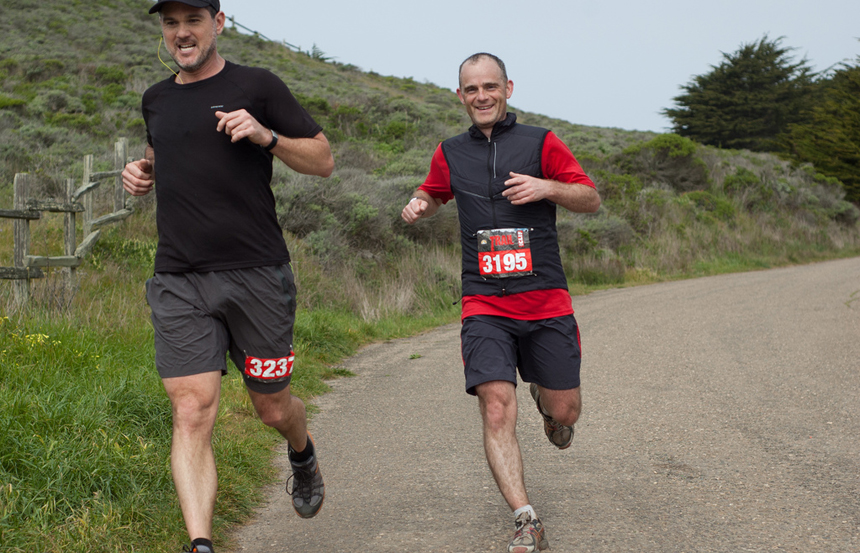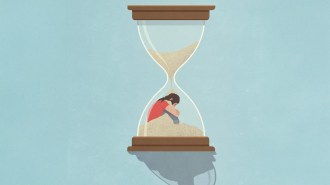To do your best, find a rival
A new study in runners shows rivalry is linked with a performance boost

While runners generally have friendly competition in a road race, a new paper shows that sometimes rivalry can help an athlete beat a friend to the finish.
ptufts/Flickr (CC BY-NC 2.0)
- More than 2 years ago
I have been a runner for more than 10 years. For much of that time, I have been chasing Kate.
Kate is a friend of mine from graduate school. She’s one of those runners who has a gift for the sport. Naturally fast and naturally tenacious, she started beating me the day she started running races. At the last half marathon we both entered, she outran me by over 15 minutes. But I can’t stop running after her. I’m pretty sure I’ll be chasing Kate until one or both of us gets our runner’s knees replaced. Why do I bother racing after a runner I’ll never catch? I view her as a rival. And a new study suggests that keeping my rival in mind might mean that I run faster.
In a study published July 2 in Social Psychological and Personality Science, Gavin Kilduff shows that, in races, runners run faster when potential rivals are present. The study is the first to show associations among rivalry, motivation and performance, and suggests that rivalry really could up your game.
“Rivalry isn’t about liking or disliking a person,” says Kilduff, a social psychologist at New York University. “It’s more about feeling competitive, when you place greater significance on the outcome of a competition, because of the relationship you have with that person.”
Kilduff has been interested in competition and rivalry since graduate school. “Most studies of competition involve forced competition between strangers,” he explains. “The theory was that competition is this controlling force” that could end up hurting, rather than helping, performance.
But this didn’t make sense to Kilduff. He thought about rivalries, such as those in sports, where people elect to compete against one another. In those cases, rivalry and competition appear to be positive motivators. “I wanted to go beyond the competition alone to see what happens when people actually know each other,” he says.
Kilduff started with a study performed on Amazon’s Mechanical Turk, an online marketplace that pays participants for study participation. He assigned 147 participants to one of two conditions. In one, they were asked to recall a rival. In the other, they were asked to recall a competitor who was not a rival. Participants who were asked to think of rivals reported higher motivation, and also said they experienced a better performance as a result. In a further experiment, participants also stated that they competed against rivals more often than against other competitors who were not rivals.
But asking people to recall rivalries isn’t enough to link the rivalry with improved performance. Kilduff went to a small northeast running club, where 76.5 percent of amateur runners who raced frequently said yes, they did have rivals. The runners reported that rivalry gave them more motivation, and they believed that rivalry made them push themselves harder and perform better.
To look directly at performance, Kilduff looked at race scores. Many local running races have websites that record races information and results. He focused on small, local races, where the same people were likely to meet over and over again, and were very likely to know, or at least recognize, fellow runners. This would make them more likely to form rivalries.
Kilduff put together a score that took into account similarities in age and gender, how often runners competed against specific people, and how evenly matched the competitions appeared to be. He used the score to identify potential rivals. Then he looked at their race results.
It turns out that if at least one potential rival was present, a given runner would, in general, run faster. And quite a bit faster — about 4.92 seconds per kilometer faster, or about 7.44 seconds per mile. This may not sound like much, but in a 5-kilometer race that’s a potential time difference of up to 25 seconds, easily the difference between first place and no place at all.
The results show a link between rivalry and increased motivation and performance. But that link is not quite proof that a rival causes a runner to go the extra mile, says Thomas Britt, a social and organizational psychologist at Clemson University in South Carolina. “The objective nature of the data and the creative way Kilduff identified the presence of rivals is great,” he says. “He’s tried to rule out competing explanations, but you still can’t say that rivalry is causing the performance. You’d have to do that in an experimental setting where you could construct a rivalry.”
And while rivalry might increase motivation and improve performance on the track, it might not always be a good thing. “This paper opens a venue for the positive effects of competition,” says Kou Murayama, a psychologist at the University of Reading in England. “Of course I must emphasize that rivalry would not always facilitate performance. I can easily imagine situations where rivalry turns into fear of failure, having a detrimental effect on performance, or even increasing cheating behavior.” Kilduff agrees, and notes that “These runners are competitive people. The individuals in that situation may mean that rivalry has a positive impact. But if you’re working on a complex task, the extra arousal might not be a good thing.”
So maybe my rivalry with Kate improves my own running. Certainly, in the last race we both ran, I ran a personal best. I was happy I did well. But I would have been happier if I’d beaten Kate.







